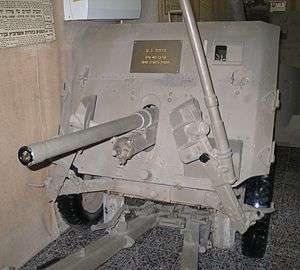Ordnance QF 2-pounder
| Ordnance QF 2 pounder | |
|---|---|
|
The QF 2 pounder in Batey ha-Osef Museum, Israel. Note the folded legs of the carriage. | |
| Type |
Tank gun Anti-tank gun |
| Place of origin | United Kingdom |
| Service history | |
| In service | 1936–1945 |
| Used by |
United Kingdom Australia Belgium Ireland Germany |
| Wars | World War II |
| Production history | |
| Designed | 1936 |
| Manufacturer | Vickers |
| Produced | 1936–1944 |
| Number built | 12,000[1] |
| Specifications | |
| Weight | 814 kg (1,795 lb) |
| Barrel length |
overall: 2.08 m (6 ft 10 in) L/52 bore: 2 m (6 ft 7 in) L/50 |
| Crew | 3–5[1] |
|
| |
| Shell | 40×304 mm. R |
| Calibre | 40 mm (1.575 in) |
| Breech | semi-automatic vertical block |
| Recoil | hydrospring |
| Carriage | three-leg platform |
| Elevation | -13° to +15° |
| Traverse | 360° |
| Rate of fire | 22 rounds per minute |
| Muzzle velocity | 792 m/s (2,600 ft/s) with AP shot |
| Effective firing range | 914 m (1,000 yd) |
| Maximum firing range | 1000 m (1093.6 yd)[1] |
| Feed system | Breech-loaded |
| Sights | No.24b |
The Ordnance QF 2-pounder (QF denoting "quick firing"), or simply "2 pounder gun", was a 40 mm (1.575 in) British anti-tank and vehicle-mounted gun, employed in the Second World War. It was actively used in the Battle of France, and during the North Africa Campaign. As Axis tanks improved in armoured protection, it lost effectiveness, and it was gradually replaced by the 6-pounder, starting in 1942, though some remained in service until the end of the war. In its vehicle-mounted variant, the 2-pounder was also a common main gun on British tanks early in World War II, and was a typical main armament of armoured cars, such as the Daimler, throughout the war.
This QF 2-pounder was not the same gun as the QF 2 pounder "pom-pom" gun extensively used by the Royal Navy as an anti-aircraft gun; they shared only the projectile weight of 2 pounds (0.9 kg).
History
The gun was developed as both a tank weapon and an anti-tank gun. For reasons of economy and standardization, it was accepted - as the 2-pdr Mark IX - for both purposes in October 1935. Carriages for the gun were designed by Vickers and the Design Department at the Woolwich Arsenal.[2]
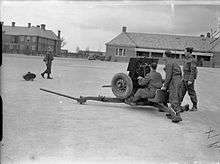
Vickers was the first to submit a design, which was accepted as the Ordnance QF 2-pounder Mark IX on Carriage Mark I. A limited number of pieces was built in 1936. The carriage had an innovative three-legged construction. In the travelling position, one of the legs was used as a towing trail, and the other two were folded. When the gun was positioned for combat, the legs were emplaced on the ground and the wheels were lifted up. Woolwich Arsenal had continued to develop their carriage and when re-examined was seen to be superior to Vickers design, and with this carriage the gun was adopted as Ordnance QF 2-pounder Mark IX on Carriage Mark II. It was conceptually similar, although when the gun was emplaced for combat the wheels had to be removed. This carriage was also manufactured by Vickers.[2]
The unusual construction gave the gun good stability and a traverse of 360 degrees, allowing it to quickly engage moving vehicles from any approach. With the Vickers carriage, the gun could also be fired from its wheels, at the expense of limited traverse. The 40 mm 2-pounder could outperform a typical 37 mm piece, such as the German 3.7 cm PaK 36 or the Bofors 37 mm, and significantly outclassed 25mm and 20mm weapons of that era. A drawback of the 2-pounder was that it was nearly twice as heavy as the PaK 36 and had a higher profile.
The gun was first put into use on a tank as the main armament of the Vickers-designed Cruiser Tank Mk I.
A late-war project was the Canadian David High Velocity to allow 2-pdr ammunition to be fired from the larger-calibre 6-pdr. This was intended to improve the muzzle velocity of the shot. The system was still being developed when the war ended, the program ending along with it.
Another development was the 2-pdr HV 'Pipsqueak', a postwar gun using a 40x438R cartridge originally intended as the main armament for the Saladin armoured car that was to replace the AEC Armoured Car. This was designed to fire Armour-piercing discarding sabot (APDS) rounds, which would match the penetration of the 'Littlejohn' shot while still allowing high-explosive (HE) shells to be fired. In fact, the claimed performance was better, the 1,295 m/s shot penetrating 85mm of armour at 60 degrees at 900m. Development of this gun was also abandoned when the role of the Saladin shifted towards infantry fire support, and a low-velocity 76mm cannon was selected for it instead.
One of the most serious shortcomings of the 2-pdr was the lack of a high-explosive shell, especially when the 2-pdr was the main gun of a tank; this was very important when a tank was being used for infantry support, leaving it with only its machine gun for anti-personnel use. A high-explosive shell was designed for the 2-pdr, but never produced.[3]
Combat service
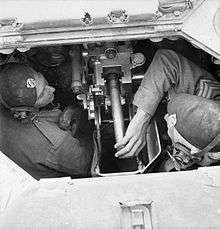
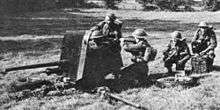


The 2-pdr gun became a part of the Royal Artillery in 1938, when five field brigades were converted to anti-tank regiments.[4] In the early western campaigns, the 2-pdr was employed by two types of Royal Artillery formations: anti-tank regiments of infantry divisions (four batteries with 12 pieces each), and light anti-aircraft/anti-tank regiments of armoured divisions (two 12-gun AT batteries). From October 1940, separate 48-gun anti-tank regiments were introduced in armoured divisions too. Infantry brigade structure initially included an anti-tank company, though it was typically equipped with 25 mm Hotchkiss anti-tank guns; these companies were disbanded later in the war. From 1942, infantry battalions received their own six-gun anti-tank platoons. The organization was different in the Far East theatres. The exact internal structure of AT units was also subject to changes and variations.
The gun first saw combat with the Belgian Army during the German invasion of the Low Countries, and then with the British Army during the subsequent rear-guard actions at Dunkirk. Most of the British Army's 2-pdrs were left behind in France during the retreat, stripping most of the army's infantry anti-tank capability. Those guns captured at Dunkirk entered German service under the designation 4.0 cm Pak 192 (e) or 4.0 cm Pak 154 (b), the "e" and "b" referring to the origin (English or Belgian Army).
Although the Woolwich Arsenal had already designed a successor to the 2-pdr, the 6 pounder gun, it was decided in the face of a likely German invasion to re-equip the army with the 2-pdr, avoiding the period of adaptation to production, and also of re-training and acclimatization with the new weapon. This had the effect of delaying production of the 6 pounder until November 1941, and availability to frontline units to spring 1942. Consequently, for most of the North African Campaign, the army had to rely on the 2-pdr, aided by the 25 pounder gun-howitzer functioning as an anti-tank gun—a role for which it was capable, though at the expense of taking it away from its main artillery role. As German tank design evolved, anti-armour performance of the 2-pdr gradually became insufficient; however, the gun owes a large part of the bad reputation it gained during the campaign to the open terrain, which made the high-silhouette piece hard to conceal, and to poor tactics.
In North Africa, it was found that the 2-pdr was damaged by being towed long distances across rough, stony deserts. Starting in 1941, the British developed the "en portee" method of mounting the 2-pdr, and later the 6-pounder, on a truck. Though only intended for transport, with the gun carried unloaded, crews tended to fire from their vehicles for more mobility, with consequent casualties. Hence the vehicles tended to reverse into action so that the gunshield of the 2-pdr would provide a measure of protection against enemy fire.
From mid-1942, the 2-pdr was increasingly displaced to infantry anti-tank platoons, to Home Guard units in Great Britain, and to the Far East, where it was still effective against the smaller and more lightly armoured Japanese tanks. It was finally removed from service entirely in December 1945. As a vehicle weapon, it remained in use throughout the war. Although most tanks equipped with it were withdrawn or upgraded to the 6-pdr, it remained in use with armoured cars.
Its performance as an anti-armour weapon was improved later in the war with the development of more sophisticated ammunition and got an additional boost with the introduction of the Littlejohn adaptor, which converted it to a squeeze-bore design firing specially-designed shells at much higher velocities. (However, the Littlejohn adaptor prevented the use of High Explosive rounds.) These improvements, however, were constantly outpaced by improvements in tank design.
The guns were never equipped with High Explosive rounds, which would have given the gun some capability against un-armoured targets. The shells had been designed, but were not introduced because it was felt that the small amount of explosive contained in such a small shell (which weighed about the same as the popular Mills bomb hand grenade) would be ineffective. This proved to be a problem in combat when duels broke out between opposing anti-tank gun units. It also presented a major problem for armoured vehicles equipped with the gun, which could not deal with opposing anti-tank guns and their crews at distances beyond the range of their machine gun.
Ammunition
| Type | Model | Shot/shell | Round weight | Projectile weight | Filler | Muzzle velocity |
|---|---|---|---|---|---|---|
| Armour-piercing, tracer | AP/T Mk I | Shot | 2.04 kg (4.5 lb) | 1.08 kg (2.4 lb) | 792 m/s (2,600 ft/s) | |
| Armour-piercing, tracer, increased charge | APHV/T | Shot | 2.04 kg (4.5 lb) | 1.08 kg (2.4 lb) | - | 853 m/s (2,800 ft/s) |
| Armour-piercing, capped, ballistic cap, tracer | APCBC/T Mk I | Shot | 2.22 kg (4.9 lb) | 1.22 kg (2.7 lb) | - | 792 m/s (2,600 ft/s) |
| Armour-piercing, composite non-rigid (used with the Littlejohn adaptor) |
AP/CNR (APSV) Mk I | Shot | ? | 0.57 kg (1.3 lb) | - | 1,280 m/s (4,200 ft/s) |
| Armour-piercing, composite non-rigid (used with the Littlejohn adaptor) |
AP/CNR (APSV) Mk II | Shot | ? | 0.45 kg (0.99 lb) | - | 1,189 m/s (3,900 ft/s) |
| High-explosive, tracer (never placed in production)[3] |
HE/T Mk II | Shell | 1.86 kg (4.1 lb) | 0.86 kg (1.9 lb) | Lyddite | 792 m/s (2,600 ft/s) |
| Distance | 91 m (100 yd) | 457 m (500 yd) | 914 m (1,000 yd) | 1,371 m (1,499 yd) |
|---|---|---|---|---|
| AP (meet angle 60°) | 49 | 37 | 27 | 17 |
| APHV (meet angle 60°) | 54 | 41 | ||
| APCBC (meet angle 60°) | 53.5 | |||
| Different methods of armour penetration measurement were used in different countries / periods. Therefore, direct comparison is often impossible. | ||||
Variants
Gun variants:
- Mk IX - main pre-war production version, with barrel of autofrettage construction.
- Mk IX-A - Mk IX simplified for mass production.
- Mk X - later production version, with forged barrel.
- Mk X-A - Mk X with dimension tolerances reduced.
- Mk X-B - main late-war vehicle version, fitted with the Littlejohn adaptor.
Carriage variants:
- Mk I - Carriage designed by Vickers.
- Mk II - Carriage designed by the Royal Arsenal.
Self-propelled mounts
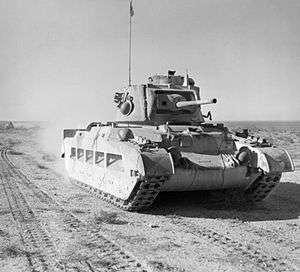
.jpg)
- Tanks
- Light Tank Mk VII, Tetrarch, Light Tank Mk VIII, Harry Hopkins
- Cruiser Tank Mk I to Cruiser Tank Mk VI, Crusader
- Infantry Tank Mk II, Matilda, Infantry Tank Mk III, Valentine, Infantry Tank Mk IV, Churchill (early marks)
- Ram I (Canada)
- AC1 Sentinel (Australia)
- Armoured cars
- AEC Armoured Car
- Coventry Armoured Car
- Daimler Armoured Car
- Marmon-Herrington Armoured Car (South Africa)
- Rhino Heavy Armoured Car (Australia, prototype only)
- Other vehicles
- 2 Pounder Anti-tank Gun Carrier (Australia, used for training)
- Loyd Carrier[7] (experimental)
Surviving examples
There is an Irish Army QF 2 pdr in the museum in Collins Barracks in Dublin City.
See also
- QF 2 pounder naval gun "pom-pom" AA gun, of the same bore but with a pre-World War I heritage.
- British standard ordnance weights and measurements
References
- Notes
- 1 2 3 Military Factory: Ordnance QF 2-pounder Anti-Tank Gun
- 1 2 Henry 2004, p. 6–7.
- 1 2 Ian Hogg, Tank Killing, page 138-139, published 1996 by Sidgwick & Jackson ISBN 1-885119-40-2
- ↑ Henry, Chris (2004). British Anti-tank Artillery 1939-45, Osprey New Vanguard No.098, p.39
- ↑ Hunnicutt, R. P. - Sherman: A History of the American Medium Tank., p 496.
- 1 2 Guns vs Armour 1939 to 1945.
- ↑ Chamberlain, Peter and Gander, Terry - Anti-Tank Weapons, p 38.
- Bibliography
- Hogg, I. V. (1998). Allied Artillery of World War Two. Ramsbury: Crowood Press. ISBN 1-86126-165-9.
- Chamberlain, Peter; Gander, Terry (1974). Anti-Tank Weapons. WWII Fact Files. New York: Arco Publishing. ISBN 0-668-03505-6.
- Henry, Chris (2004), British Anti-tank Artillery 1939–45, New Vanguard, Osprey, ISBN 9781841766386
- Hunnicutt, R. P. (1994). Sherman: A History of the American Medium Tank. Presidio Press. ISBN 0-89141-080-5.
- "British Guns 37mm and 40mm calibre: penetration table". Guns vs Armour 1939 to 1945. Retrieved 18 November 2014.
- Further reading
- Williams, A. G. "37mm and 40mm guns in British service". Retrieved 18 November 2014.
External links
| Wikimedia Commons has media related to QF 2 pounder. |
